From
my recent diary
2021
Unless
otherwise noted I use the following materials since the end of October,
2018.
Telescope: D: 45.5cm f: 2037mm
Dobsomian (Newtonian reflector)
Eyepiece: and magnification: Lavendura
63mm, apparent FOV 45 deg. with Paracorr
x37, actual FOV 1.2 deg.
Night Vison: ACT
PVS-14 Photonis 4G INTENS 1800 Auto gate P45 WP
Wednesday, December 31
Finally, today is New Year's Eve. Tuesday 15 was the last comet hunting
session this month, though I had eight hunting sessions in December.
Unexpectedly, I had less hunting sessions than usual in the latter half of
this month due to continuous nasty weather in addition to moonlight. I did
not have enough observation of C/2021 A1 Leonard that outbursted after
moving from the predawn sky to the dusk. I describe on the hunting session
on Tuesday 15, observations on Wednesday 22 and Tuesday 28 in this month.
Tuesday, 15
I began searching with M3 at predawn. However, I encountered no Deep Sky
Objects in spite of the use of Night Vison. There are not bright galaxies
in the northern region of M3.
On the day, I tested some eyepieces before the comet searching session. I
evaluated four eyepieces, i.e., Ethos 13 mm, Nagler Type 4 12 mm, XW 10 mm
and Carl Zeiss Jena (CZJ) H-25 mm that I got through an online auction
lately combined with a 2x barlow lens. They were used with my 46 cm
reflector that was trained at M3.
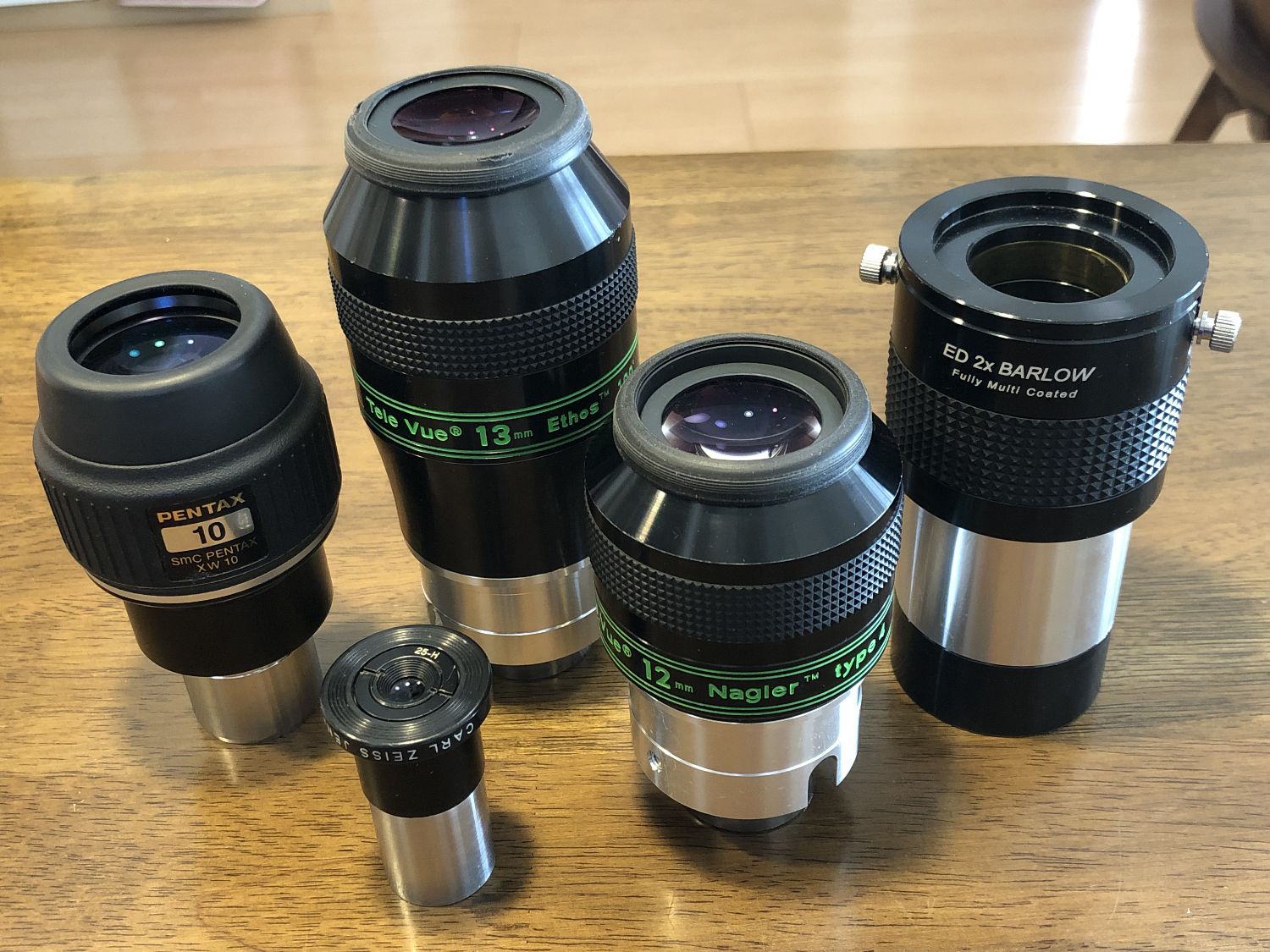
Four eyepieces tested with the 2x barlow lens.
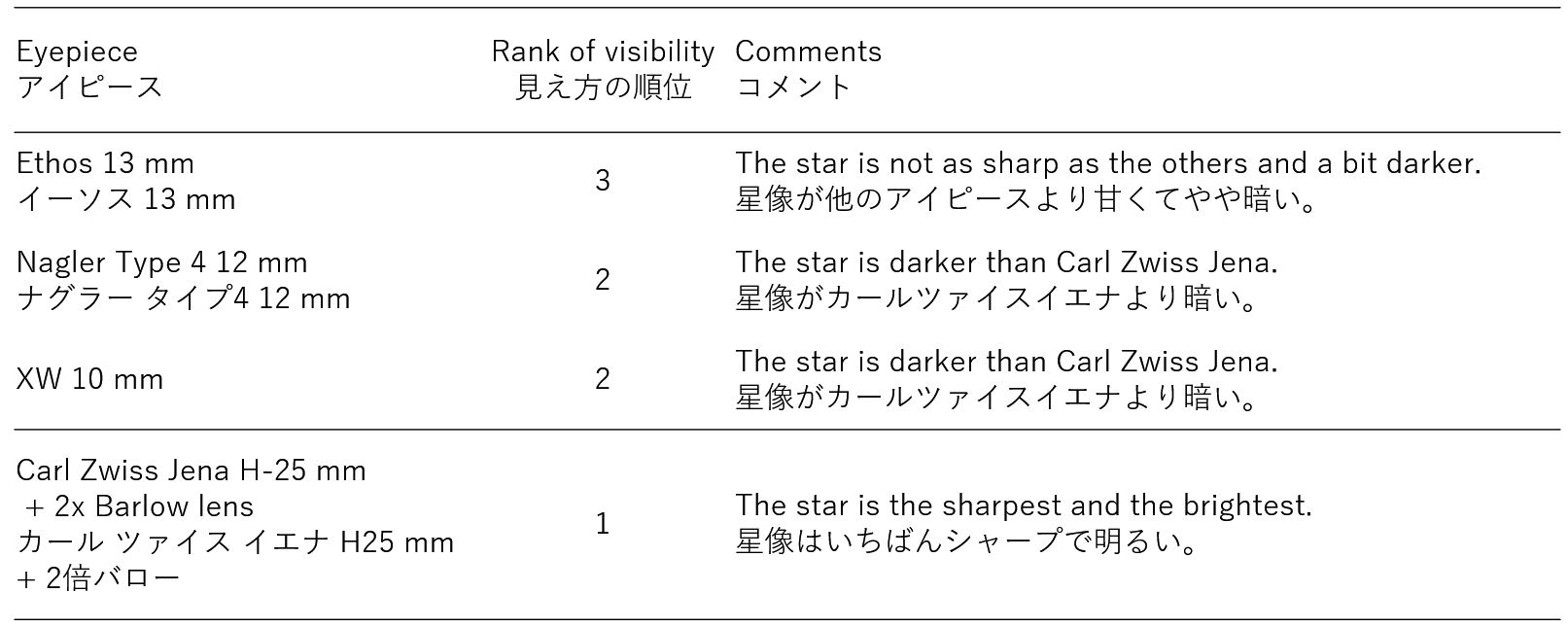
Results of evaluation.
The best one was CZJ H-25 mm, followed by XW 10 mm and Nagler 12 mm that
were equivalent, and Ethos 13 mm. I purchased CZJ because I found a claim
on a blog that said CZJ is the best eyepiece for planetary observing when
it is employed in combine with a barlow lens.
https://m-lambda.blogspot.com/2021/11/blog-post.html
In my impression of evaluation seeing M3, I think it is true and looking
forward to see planets in practice.
Wednesday, 22
I tried to observe C/2021 A1 Leonard at my house where the sky is light
polluted. Unfortunately, the transparency was poor, but I could manage to
confirm the existence of the comet at low altitude using 20 cm reflector
with Ethos 21 mm. With Night Vison 15x the comet had a developed envelope
and was shining. It was vivid and looked like a photo image. I want to
keep observing this comet.

From left to right: Night Vision PVS-14, Lavendura 63 mm, Paracorr
Tuesday, 28
I went observing C/2021 A1 Leonard at a site where it took 45 minutes from
my residence with the altitude of some 900 m above sea level. At 5:30pm
local time there were clouds lower than the altitude of 5º above the
horizon, but at 6pm they reached 30º and the comet had been hidden by the
clouds.
I waited until 6:40pm but they did not disappear. I decided to take down
my telescope. After 7pm when I had almost completed taking down my comet
seeker, clouds began to dissipate. I have confirmed the comet that was at
the altitude of about 3º using 7x50 mm binocular, and I also saw the
existence of the tail. I regret I should have persisted more.
I hope this comet keep having splendid appearance until next year and
prepare to the next observation.
Wednesday, November 17
This was the nineth comet hunting session in November. This predawn it
was clear sky with no clouds, although there were a lot of clouds and I
was forced to interrupt and consumed time yesterday. Before the session I
enjoyed observing 67P Churyumov-Gerasimenco and C/2021 A1 Leonard. Those
two comets looked similar with respect to shape, brightness and lengths of
tails: 10th magnitude, diameter 4', DC=4 and tail length of 0.4°. I could
not find any difference in appearance of each comet depending on the
eyepiece used, i.e. between Night Vison and Ethos 21 mm.
I decided to apply to Ethos 21 mm instead of Night Vision due to good
transparency. At 4:21am local time I began the searching session with M65
that rose at the altitude of 40°. I make it a rule to search the altitude
of 30° or lower, but it is not so strict. Most part of the sky I swept
during the session was the constellation of Virgo where there are quite a
few of galaxies. As a result I identified 56 galaxies in total, but I
remember the record high was 70 galaxies during one comet hunting session.
The zodiacal light was so bright that I could not encountered a galaxy of
13th magnitude of darker. Three galaxies NGC4294 (magnitude of 11.8), 4299
(12.3) and 4313 (12.0) were seen in the same field of view, but I could
not notice NGC4330 (12.4).
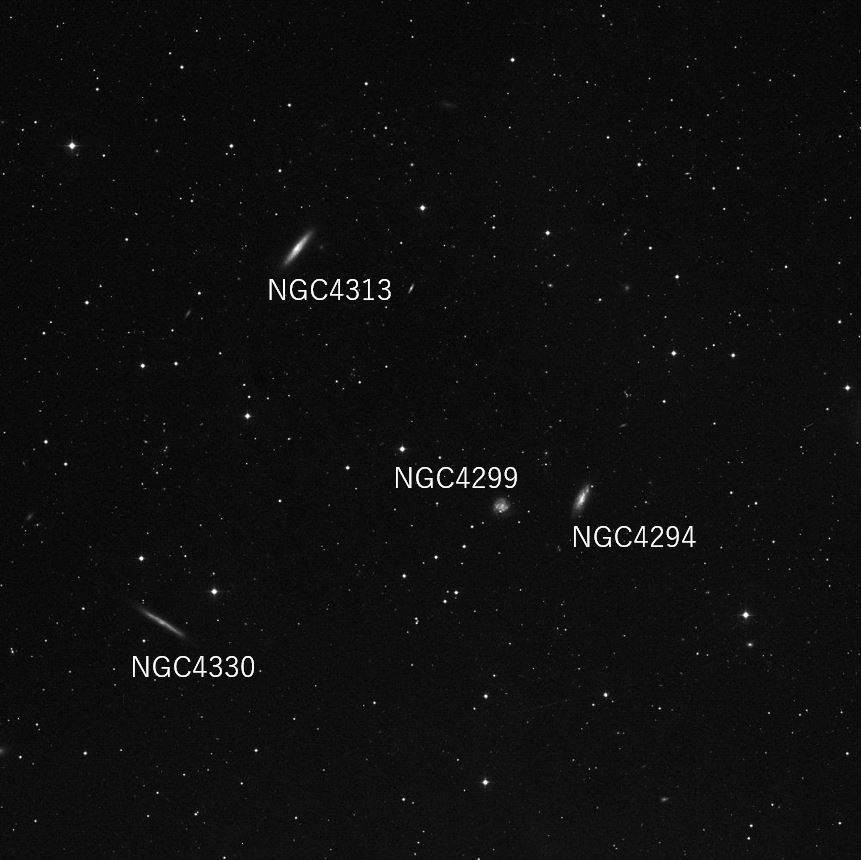
NGC4294, 4299, 4313 and 4330. The image is 60' wide.
The Digitized Sky Survey copyright © 1994
Last month I noticed the light pollution of Nobeoka City with the
population of 120,000, 55 km east-southeast of the observing site, but
this month I could not because the zodiacal light is in the same direction
of the city. The zodiacal light was brighter than the light pollution of
Oita City, population 470,000, 60 km northeast of the site.
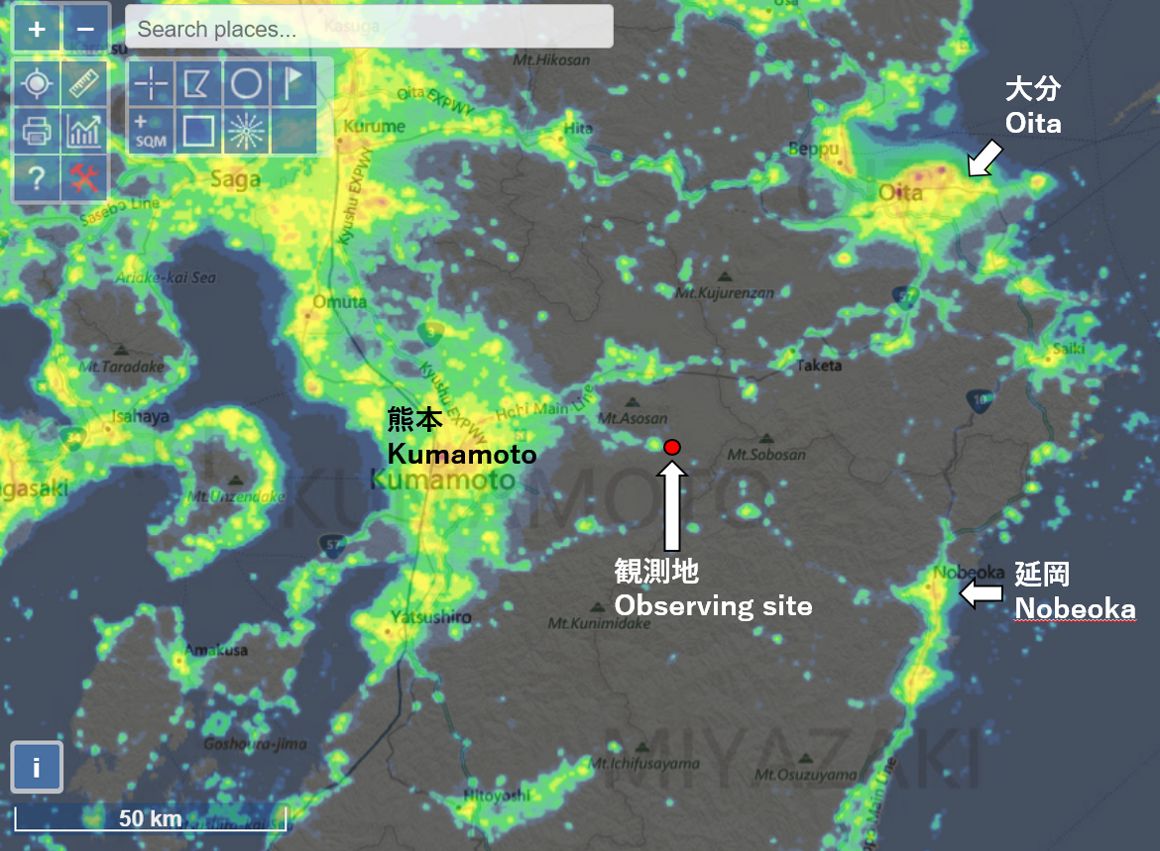
Location of the site, Nobeoka City, Oita City and Kumamoto City.
https://www.lightpollutionmap.info
About a week from now I do not conduct a comet searching session because
of the moonlight.
Thursday, October 7
This was the fourth comet hunting session in October. I enjoyed
observing 4P Faye and 67P Churyumov-Gerasimenko before the hunting
session. 4P was estimated as the 11th magnitude, apparent diameter of 3',
tail 1', DC=4, while 67P the 10th magnitude, 1.5', tail 0.2° and DC=7. 29P
was in the outburst and I observed it the day before (11th mag., 0.5',
DC=7), but I did not saw the comet this time to save time.
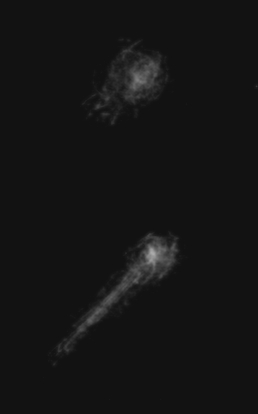
Quick sketches of 4P Faye (upper image) and 67P Churyumov-Gerasimenko
(lower one) using 46 cm 97x, Ethos 21 mm. The zenith is downward.
I started the comet hunting session with omicron Leonis to overlap the
last session. I employed the glass eyepiece, Ethos 21 mm, instead of Night
Vision as the transparency was pretty good. The first DSO passed through
the FOV was M44. It was exciting to see the herds of glistering stars that
extended out of the FOV going through. The next object was NGC2672, a 11th
magnitude galaxy, located some 2° in the east of M44. I noticed another
galaxy, NGC2673, was 0.5' to its east upon identifying NGC2672 using the
digital map, SkySafari 6 Pro. Definitely, I recognized NCG2673 with carful
observation. In the same way, when I confirmed NGC2749, a 11th magnitude
galaxy located at about 6° east of M44, I noticed the existence of another
galaxy in the same FOV: the 13th magnitude galaxy, NGC2744. All of them
are in the constellation of Cancer, and the background was bright because
of zodiacal light. As the result, I overlooked those 13th magnitude
objects using 46 cm at the altitude of some 30°. Incidentally, the day
before I noticed the 13th magnitude galaxy in Hydra, NGC2723, located off
the ecliptic.
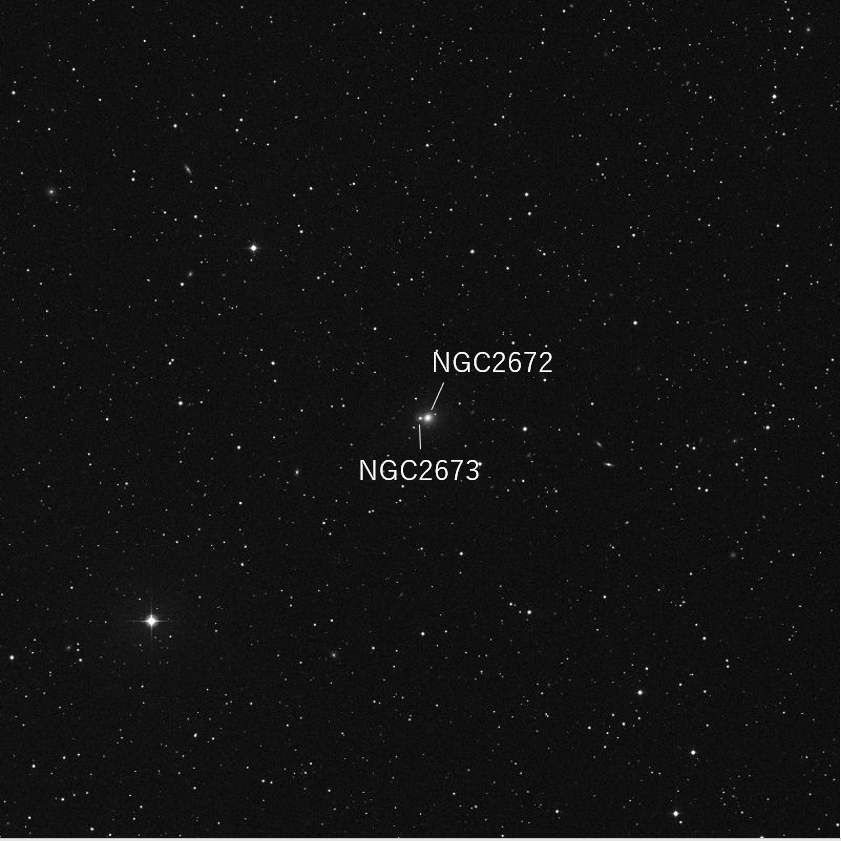
NGC2672 and NGC2673. The image is 60' in wide.
The Digitized Sky Survey copyright © 1994
After a while a remarkably bright galaxy came into the FOV: NGC2903, an
8th magnitude galaxy in Leo. When I observed it on Sunday, October 3, the
moon was age 26. The image was 2 or 3 magnitude brighter than it was then.
I realized that even the crescent moon can have a significant impact. Two
9th magnitude galaxies, M105 and NGC3384, passed through the FOV during
the twilight. There must be the 11th magnitude galaxy, NGC3389, in the
FOV, but I could not see it due to zodiacal light.
Leo in October. As Tsutomu Seki mentioned, many new comets have been
discovered in the constellation in the month. Seki himself did C/1961 T1
Seki, and I myself spotted C/2006 T1 Levy on October 3.79236 UT, 2006,
though Levy's discovery had been made public before I reported and my name
was not attached to it. When I completed the session, Leo appeared on the
horizon in all its majestic glory.
Sunday, September 19
Finally, we had clear sky at predawn since 6th August when I conducted
the comet hunting session last. Today, the dark night period was limited
to 43 minutes, i.e. the moonset was 3:56a.m. local time and the start of
the twilight 4:39a.m. I set up my telescope earlier than the moonset, and
began to observe some bright comets.
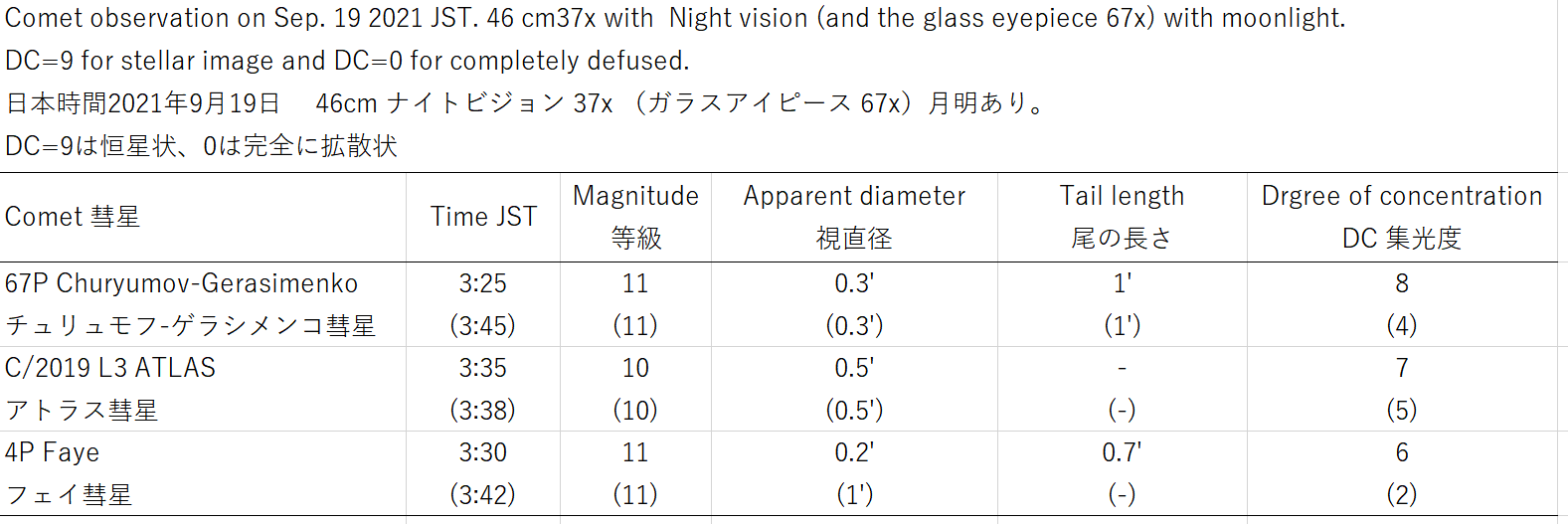
I compared the appearance of three comets using Night Vison (NV, 37x) and
a glass eyepiece (Planokular 30 mm, 67x). Both the values of the magnitude
and the apparent diameter were determined by intuition instead of applying
the standard methods selecting comparison stars. As shown in the table,
there was no difference in the magnitude between NV and the glass
eyepiece, while diameters, DC and the presence of tail were dependent on
the comet. Which is better way to spot a comet? The answer depends on the
comet, and I cannot say which is suitable. I have tested many times but
the conclusion is the same.
I began to search in the vicinity of Sirius at 3:49a.m. I looked back at the last year's diary I found
I swept the same area on September 21. It aimed at targeting the sungrazer
comet, and I identified the same objects today and the today last year.
They were M93 at an altitude of only 7°, NGC 2359 also known as Thor's
Helmet that is an emission nebula in the constellation of Canis Major,
wonderful compact open clusters Melotte 71 and 72 and so on.
Today's highlight was the scenery that the zodiacal light that rose from
the head of Leo and the winter Milky Way crossed. Starting tomorrow,
sweeping the sky at predawn is closed for a while due to moonlight.
Tuesday, August 31
I conducted comet hunting sessions only on 5 and 6 August this month, and
it has been cloudy and rainy on the other days. Recently, the same pattern
is repeated many times; even if the weather is fine in the daytime, it
turns cloudy in the nighttime.
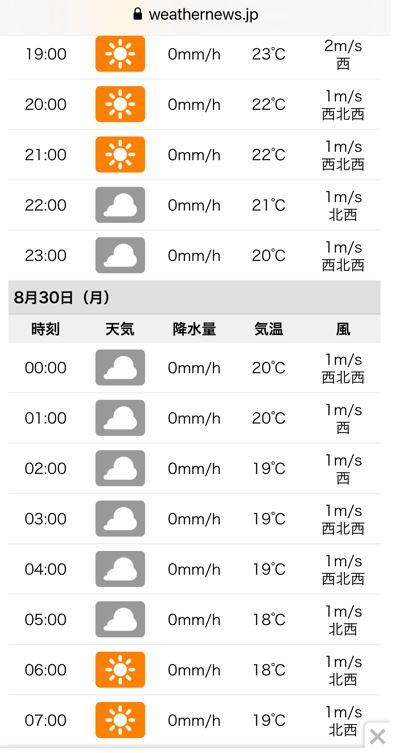
The forecast from 29 August to 30 at the observing site. Cloudy from the
midnight to the predawn. https://weathernews.jp/
On 5 August I had to get back near my house to search the sky as soon as I
arrived at the usual observing site, because the site was covered with a
dense fog. At the site near my house, I could identify no DSOs due to poor
sky condition in spite of employing Night Vision.
On 6 August the sky was clear with good transparency, though seeing was
poor. Under the condition I swept the sky using a glass eyepiece
(Planokular 30 mm + Paracorr) with 78x. Before the start of the session, I
tried observing 15P Finley, 4P Faye and C/2019 ATLAS. C/2019 L3 was easy
to observe and noticed it at a glance, but I could not recognize the other
two.
During the hunting session I saw many meteors of Perseids that had been
already active. All the DSOs I detected in the session were NGC1550 (12th
magnitude galaxy), and two reflection nebulae, M78 and NGC2071. I
challenged observing C/2021 O1 Nishimura, but it was too low in the
altitude and I could not.
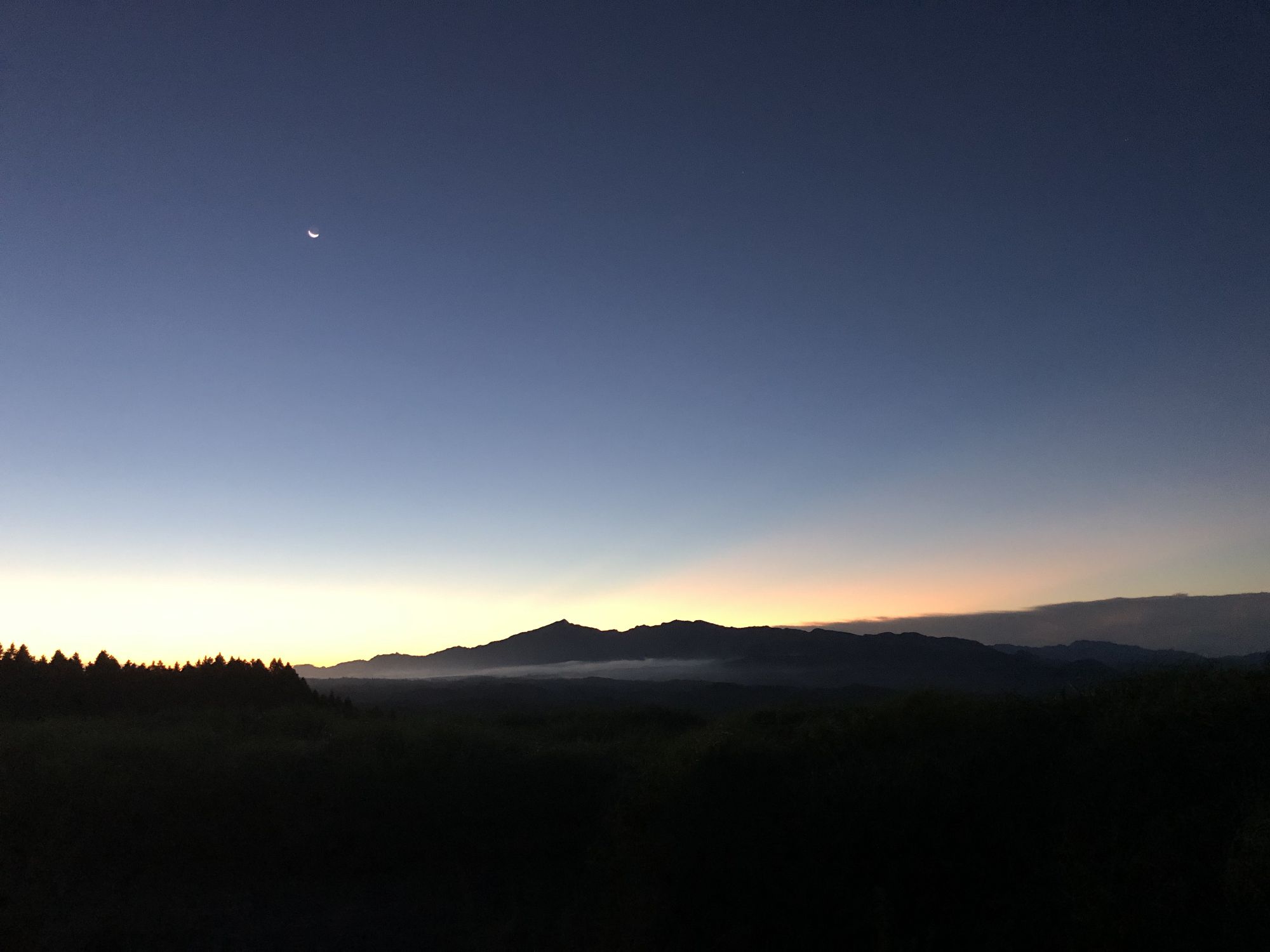
Mt. Sobosan at the daybreak.
I was a bit disappointed since I was not able to see as many comets and
DSOs as I expected. Even so, I felt refreshed as I saw meteors and
beautiful Mt. Sobosan after a long interval when I completed the comet
hunting session.
Tuesday, July 27
Hideo Nishimura discovered a 10-th magnitude new comet at predawn on
July 21 UT!
Japanese amateurs discovered comets two years in a row; Iwamoto did C/2020
A2 last year. It has been cloudy and rainy in Kumamoto since May, but it
was clear sky some parts of eastern Japan.
Some astronomers commented that the comet could be observable visually,
because it is well condensed in photos. Finally, it was fine at predawn
today, and I could observe the comet; however, it was challenging under
the waning gibbous moon. As shown in the table, I made a trial to observe
the comet several times after it reached the altitude of 3.7° above the
horizon. At the altitude of 5.0° C/2021 O1 looked stellar using Night
Vision (NV). As it was stellar, it was impossible to discover the comet
during the hunting session. When the object rose as high as 6.4°, I could
see it using Ethos 21 mm, 97x. Nonetheless, the image was extremely faint,
and again it was impossible to discover the comet of this image.
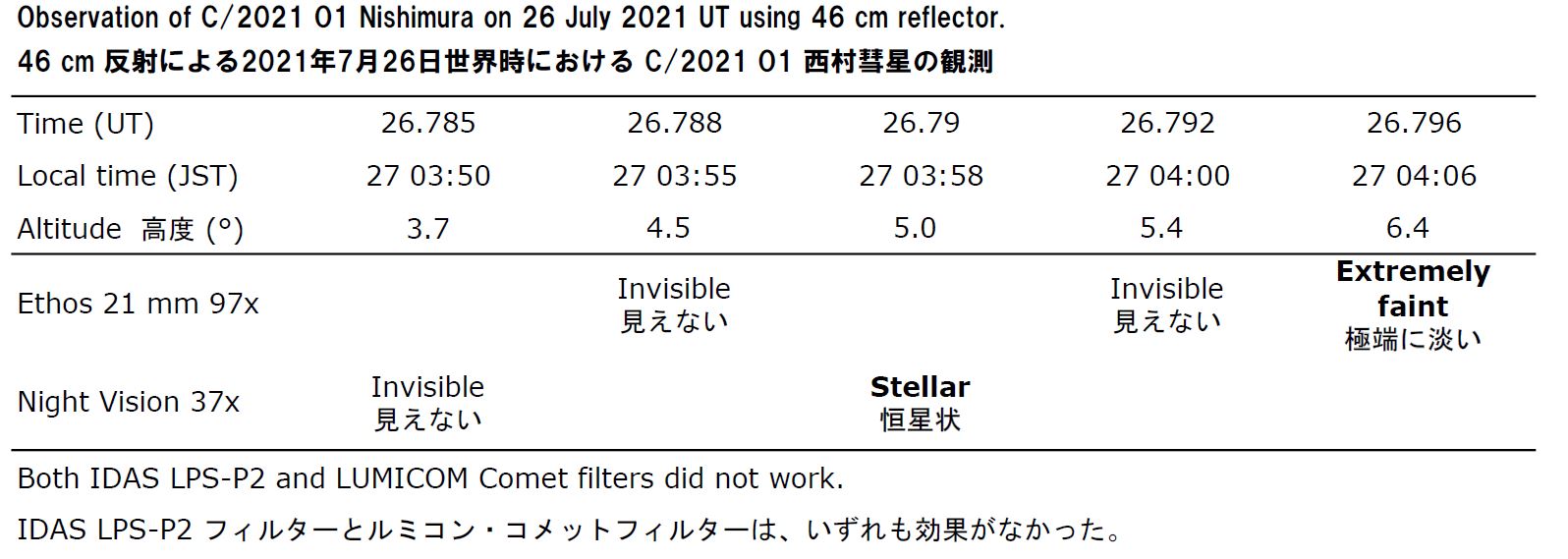
I applied IDAS LP2, a light pollution filter, and Comet filter of Lumicon
to NV and Ethos 21 mm, but both filters did not work. The comet is not
gas-rich with strong Swan band emission, because Comet filter did not
function.
Getting back to time before rising C/2021 O1, I tried to observe three
comets using NV and Ethos 21 mm with the two filters.
4P Faye; I confirmed this comet using the combination of Ethos 21 mm and
Comet filter only. The image was too dim to discover during the hunting
session.
7P Pons-Winnecke; This comet was observable using NV without filter. The
other combination did not work.
15P Finlay; I could not observe this object using any eyepiece and filter.
I was happy to observe C/2021 O1 that is difficult to observe with time,
though the moon phase was gibbous waning. As I have experienced, I
confirmed it was challenging to spot a comet with 10 to 11th magnitude
under the bright moonlight. To spot comets of that magnitude the moon
phase should be the last quarter or darker.
Thursday, July 22
Again, we have no clear sky and I could not have comet hunting session
this month, and there is no prospect to have a fine day in the near
future. In these days even if the weather is fine in daytime, it turns
into cloudy late at night.
I took a look at the number of comet hunting nights in July for the latest
10 years, i.e., in 2011 and after. One night in 2020, three nights in
2018, five nights in 2015, three nights in 2014 and one in 2013. In the
other year nil. The searching activities in 2017 and before were done in
Tohkamachi, Niigata.
I picked up the record on Wednesday, July 22, 2015, the month when I spent
as many as five days for comet hunting. There is no description on the day
(today 6 years ago) in "My diary" on my web page.
Wednesday, July 22, 2015
Observing site: Tsunan-town, Niigata, moonless night
I started the comet hunting session with Deneb Kaitos, β Ceti, at 2:25am.
Galaxies identified were NGC61, 61A, 84, 86, 589, 615, 681, 720, 908 and
701: ten galaxies in total. I think NGC589 was misprinted and NGC596 is
correct.
At 2:46am I changed the eyepiece from Ethos 21 mm, 97x to Planokular 30 mm
with Paracorr because of poor seeing.
The session was completed at 3:25am but it was interrupted for 20 minutes
for some reason (not recorded in my dairy). As a result, the total time
for the session was 40 minutes.
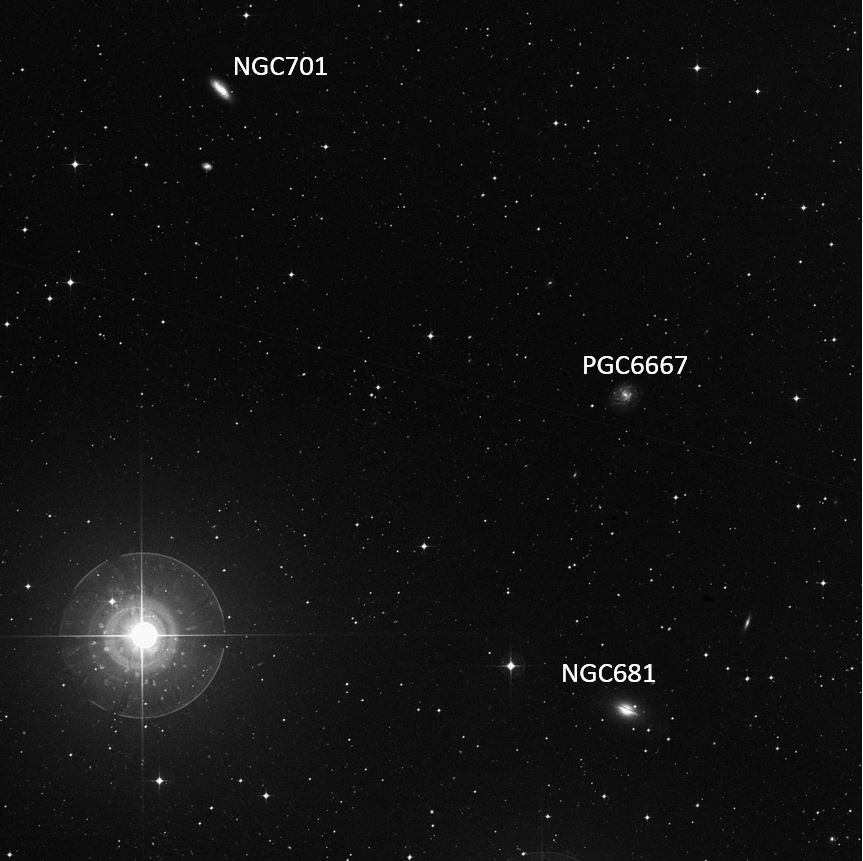
NGC681 and 701. The image is 60' wide.
The Digitized Sky Survey copyright © 1994
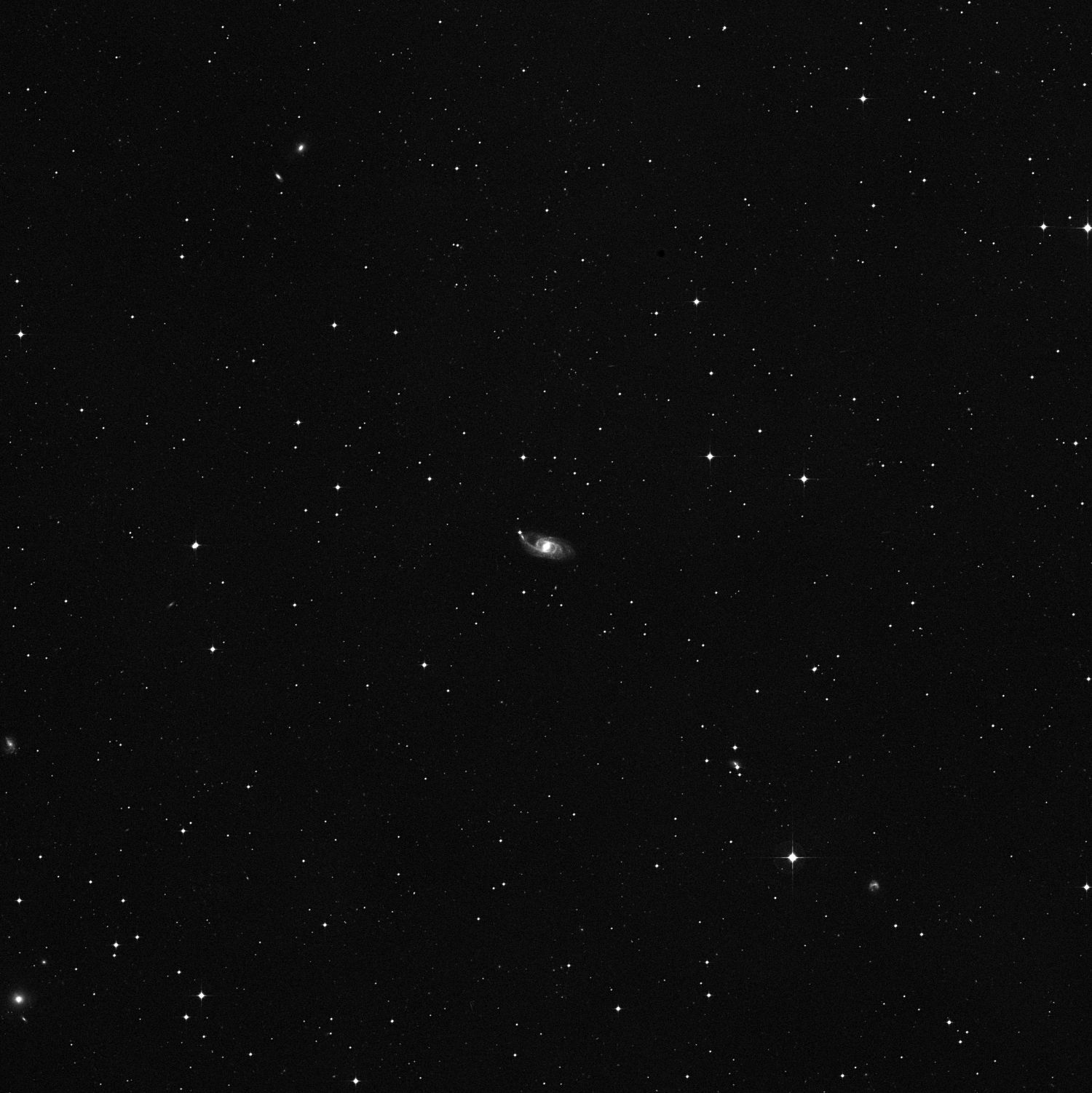
NGC151. The image is 60' wide.
The Digitized Sky Survey copyright © 1994
I checked some of the galaxies I observed using a map. I saw NGC681
(magnitude of 11.8 with the surface brightness SB of 13.6 mag per square
arcmin) and NGC701 (12.2 with SB 13.5), while I overlooked NGC151 (11.6
with SB of 13.4). NGC151 has brighter magnitude and SB than those of
NGC681 and 701.
However, as you see in the photos NGC151 has a bright central core with
faint spiral arms. I can imagine that the central core looks like a star
and arms are too faint to recognize through the telescope. Consequently, I
overlooked the object.
I often disappointed to have overlooked bright galaxies with the magnitude
of 10th to 11th. Nevertheless, I seldom did that due to lack of
overlapping of the FOV during the comet hunting session. In some cases, it
is caused by the inhomogeneous distribution of SB in the object that is
difficult to infer from the numerical data or poor sky condition. The same
holds true for comets; it is challenging to predict the comet is visible
or not based on the magnitude data alone.
Many periodic comets with the single digit designation numbers are in the
eastern sky at predawn. I expect clear sky in the coming month.
Sunday, June 27
I conducted a comet hunting session only once this month on Monday June
21. It was moonless at predawn on that day, and I expected to observe a
lot of galaxies in the eastern sky. In my experience the transparency is
often excellent in June if we have clear sky.

Nearly seven weeks have passed since I visited the observing site last.
Before I knew it the season has progressed; the constellation of Scorpion
was about to set that was the meridian transit in May when I arrived at
the site. The Milky Way was rising toward the zenith from the southwestern
horizon.
I tried to observe 7P Pons-Winnecke prior to the comet hunting session. It
took some time to identified the object, though it was reported as the
magnitude of 9.7 in a certain web site. In actuality, the magnitude was
12th with the apparent diameter of 0.2'. The image was similar independent
of the eyepieces used: Night Vison 37x or Ethos 21 mm 97x. Though I had a
plan to enjoy observing other comets, I did not, because I spent too long
time for observation of 7P. Instead, I used the time for the hunting
session.
I have started the searching session, but I could not encounter any
galaxy. The only galaxy I observed was M74, and I was disappointed. I did
not observe any galaxies with 10th magnitude or brighter, probably due to
poor transparency.
I read back my diary in June last year,
and it was found that I comet hunted only once but that I identified some
galaxies with magnitude of 12th to 13th. In
2019, I observed three times, but few galaxies were observed due to
nasty weather and moonlight. In 2018,
twice and observed many galaxies with 13th magnitude or brighter and a
planetary nebula.
I have lived in Tohkamachi, Niigata, until 2017. In
June 2017, I went to on a comet hunting session twice and identified
several galaxies. In 2016, I
observed more than a dozen of galaxies during the three times of the
session.
I will not conduct a comet hunting session this month any more because of
moonlight. I expect clear sky in July.
Saturday, May 29
The days of the comet hunting sessions in this month was only three,
Monday May 3, Tuesday 4 and Thursday 6. The Japan Meteorological Agency
said we have entered the rainy season on Saturday, 15 May, 20 days earlier
than the 30-year average, but it had been cloudy and rainy for one week
prior to their announcement. All the three days that I conducted comet
hunting sessions were moonlit. In the eastern sky at predawn in this time
of the season we see less DSOs and the moonlight made it more difficult to
observe them. All DSOs that I identified during the three days were merely
M15, NGC7177, M55 and M75. On May 4 it was impressive that some two dozens
of the Starlink satellites with the magnitude of 12th to 13th passed
through the FOV.
As I have confirmed many times, Night Vision (NV) is more effective for
visual comet searching than the conventional glass eyepiece under the
moonlight. Both C/2020 R4 ATLAS and C/2020 T2 Palomar looked brighter with
NV than with Ethos 21 mm.
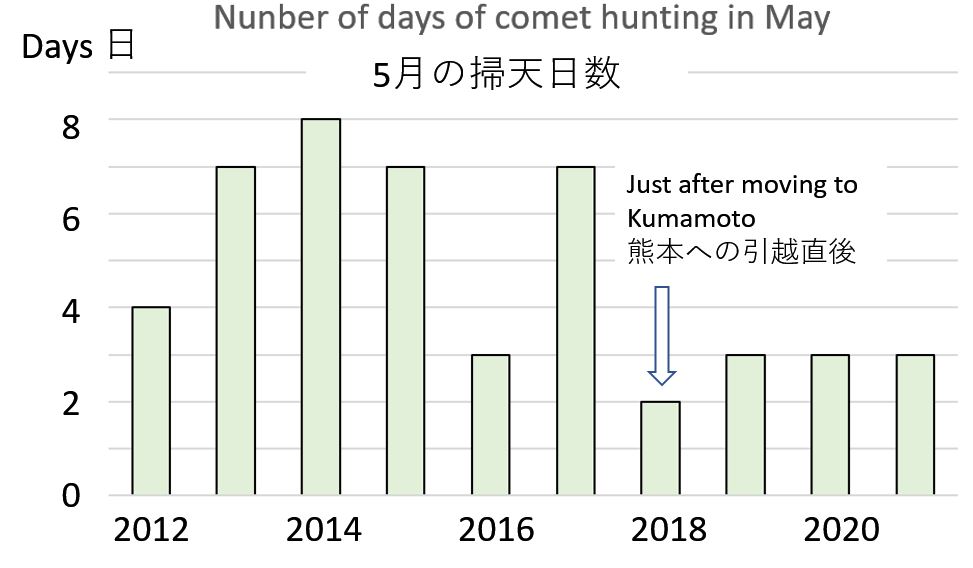
Number of days of comet hunting for the last 10 years.
Though in Niigata where I have lived until March 2018, we had many fine
days in May, conversely, in Kumamoto we have less clear sky. This is the
fourth year for me after the moving to Kumamoto. In the first year, 2018,
there were many fine days in May but I comet hunted only two days, because
of busyness just after the moving and the tight schedule of my job.
I have enjoyed the hunting session from last autumn to the end of April
very much. The total searching hours and the times of the sessions for 7
months from October 2020 to April 2021 were 74 hours 45 minutes and 58
days with monthly average of 8.3 days, respectively, which were higher
than those of the annual records after 2008 (cf. Fig.
2 in Diary in 2019). I think the major cause is that the rate of
fine days at the observing site in Takamori Town where I started to use
since last August is high.
If the volcano Aso becomes active, I cannot use the site because of the
fall of the volcanic ash. May the world be peaceful so that God in the
volcano does not get angry.
Sunday, 18 April to Wednesday, 21 April
I have comet hunted four consecutive days at predawn, and total days
of searching were seven days this month. I utilized Night Vision for all
the four days, because transparency has been poor due to yellow sand from
the continent and other causes like pollen originated from various kind of
plants that are common in spring in Japan.
Sunday
Air temperature was 2ºC. I saw a small number of stars at a low
altitude with the naked eye, but could do a lot of them using NV with the
zero magnification. I felt cold with wind. I observed two comets prior to
the hunting session. C/2020 T2 Palomar was 12th magnitude, apparent
diameter of 1' and DC=6. C/2020 R4 ATLAS was estimated as the magnitude of
11th, 3' and DC=4. Those values were determined by intuition using NV
instead of using comparison stars.
I began the session with Saturn focusing on the zodiac. I observed only
three DSOs: M72, NGC6926 and M2. NGC6926 is a galaxy in the constellation
of Aquila with the magnitude of 12.5. I could notice the object because it
came into the FOV at the altitude of 31º above the horizon that was fairly
high. M2 were resolved into stars even at the center and was impressive. I
found that the air temperature dropped down to 1ºC.
Monday
Temperature was low, i.e. 2ºC, like the day before, but I felt warmer
due to the wind less condition. I started with M2 so that the seeping area
overlapped with that on the previous day. I identified only two objects:
M15 and NGC7177, a 11th magnitude galaxy in Pegasus. The moment when I saw
the galaxy, I estimated it as 12th magnitude due to poor sky condition. I
found frost on the grass at the site, and air temperature was 1ºC when I
completed the session.
Tuesday
It was warmer than yesterday with air temperature of 4ºC. NGC7177 was
the start point of today's searching area that connected with that on
Monday. Again, only two DSOs were identified. NGC7217 is a 10th magnitude
galaxy that looked bright. I spotted NGC7331 (9th magnitude) 14 minutes
after the start of the twilight. There is Stephan's Quintet 0.5º SSW of
NGC7331. I could not spot it during searching but it was easy with
attention. I identified it during the twilight and it would be impossible
to see it with a glass eyepiece. Mt. Sobosan appeared with its holy
silhouette in the morning-glow when I was taking down my comet seeker. The
mountain has different appearance unless it is hidden in the clouds. You
can compare the photo below with those in this year and the year before in
Diary. This is wonderful observing site that can be called as "sacred
place".

Mt. Sobosan in the morning glow.
Wednesday
Air temperature was 8ºC. I stared with NGC7331 to overlap the sweeping
area with that of the day before. I also observed Stephan's Quintet in the
same FOV. The Milky Way in Cygnus and Lacerta was magnificent. The FOV was
filled with neat stars. NGC7242 is a galaxy in Lacerta with the magnitude
of 12.9 that I identified at an altitude of 24º. The galaxy forms the
galaxy group but the other galaxies was invisible due to dark magnitude of
14th. Then, I spotted M32, M31 and M110 at an altitude of 12º. M110 was
evident with NV. I tried observing it with the glass eyepiece, Ethos 21
mm. M110 looked fairly faint with Ethos 21 mm. Gamma Andromedae with the
altitude of 4º came into the FOV 32 minutes after the beginning of the
twilight, but I could not enjoy the beauty of the star as NV is in
monochrome. Again, I changed the eyepiece from NV to Ethos 21 mm. The
golden colored primary star and the light blue companion flickered by the
scintillation. How wonderful they were! I was satisfied with it and
finished the session.
Thursday, March 18
A comparison of visibility between a glass eyepiece and Night Vision:
for C/2020 T2 Palomar and C/2020 R4 ATLAS
This is the fifth comet hunting session in March. I have observed C/2020
T2 Palomar and C/2020 R4 ATLAS before the searching session. In recent
days I used NV instead of glass eyepiece because transparency has been
poor due to disperse of Japanese cedar pollen with that of other plants.
Though I have already observed the two comets, one of the objectives to
see them was to compare the visibility of the glass eyepiece with that of
NV.
First, I observed C/2020 T2 with the glass eyepiece, Ethos 21 mm, 97x. I
trained my telescope at the comet using SkySafarai 6 Pro, a digital map,
which was connected with Nexus DSC. At a glance I could not notice any
comet-like objects in the FOV. I tried to compare the arrangement of stars
in the FOV with that on the map to identify C/2020 T2. It took several
minutes to confirm the position of the comet that was at an altitude of
around 70º: at higher altitude the accuracy of locating object gets worse
for Dobsonian. Though what I observe was not a comet-like object but a
star-like one with the magnitude of 13 to 14, I was sure it was C/2020 T2.
Then, I saw C/2020 R4 ATLAS employing the same eyepiece. It was easy to
observe in spite of the low altitude of some 12º above the horizon. I
estimated the comet as 10th magnitude, apparent diameter of 3' and DC=2 by
intuition.
I changed the eyepiece to NV with 37x and aimed my telescope at C/2020 T2.
I noticed an object that could be recognized as a comet at a glance, and
observed as a magnitude of 12, apparent diameter of 1' and DC=7. I was
sure to be able to spot the object of this image during my hunting
session. I trained my comet seeker at C/2020 R4 with the same eyepiece,
and I surely notice the existence of the comet, but somewhat hard to see
it due to lower magnification in comparison with the image seen by using
Ethos 21 mm. It looked darker than using the glass eyepiece and estimated
as the magnitude of 11, apparent diameter of 2' and DC=2.
Which eyepiece is better for comet hunting, the glass eyepiece or NV?
The answer: it is dependent of nature comets and as I have ever written it
also depends on the sky condition things like moonlight and the degree of
light pollution. As Tsutomu Seki's famous quote, there is no secret plan
to discover a new comet.
I have spent some 15 minutes for the above-mentioned observation, and
finally, I was ready to start the comet hunting session at 4:18am. I began
with Altair, alpha Aquilae, using NV. All the DSOs I identified were
globular clusters. They were only three: NGC6934, M2 and M15. All were
resolved into stars with NV. It was impressive that some stars of M2 at
the periphery were resolved even though it came into the FOV at the
altitude of only 6º.
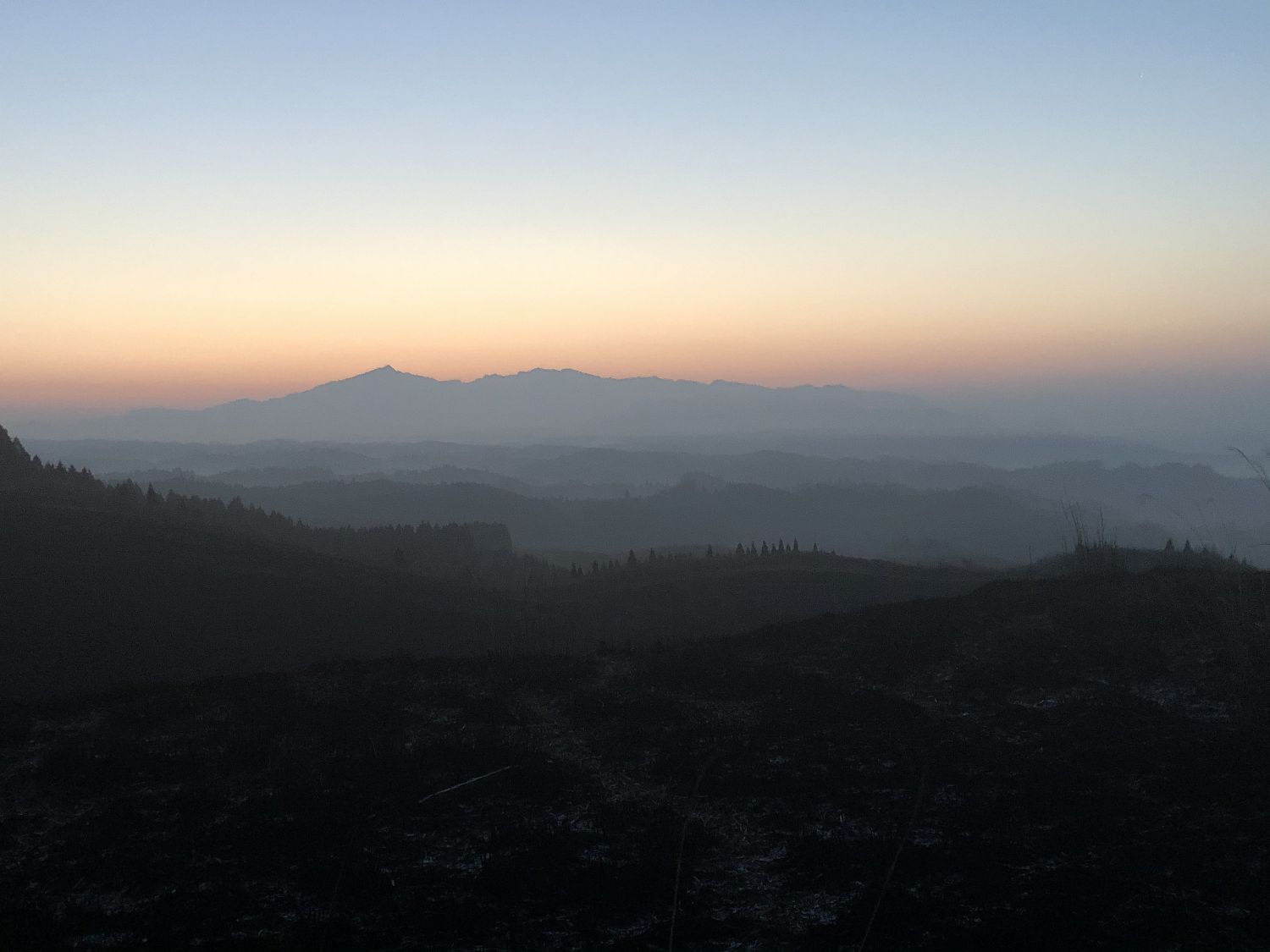
View of Mt. Sobosan from the observing site after burning the dead grass
in the field.
Movies: burning the dead grass in the field
https://www.youtube.com/watch?v=nSuDaaJipyI
Four days ago, the dead grass was burned in the field around the site, and
we are seeing drastic change in landscape. On
the photo taken last month there was Japanese pampas grass in front
of Mt. Sobosan, but it completely disappeared on the one shown above taken
today; it looks like a shot from another site. Thanks for the burning. It
keeps a good view of the site.
Friday, February 19
I arrived at the observing site at 3:45am. The condition was wonderful
with air temperature of -8 ºC, no wind and the snow depth of 3 cm. Though
the snow depth was merely 3 cm, I had to shovel the snow to some extent,
and it took more time to set up my telescope than usual. I spent as long
as 50 minutes after arrival to prepare the session, though it takes half
an hour to do under the normal conditions. When I lived in Niigata it also
took some 50 minutes to set up the telescope after the arrival during the
winter season with snow.
Prior to the comet hunting session, I observed Omega Centauri, a globular
cluster. The cluster was about 9º above the horizon, and it was easy to
spot with the naked eye. The view was awesome with 46 cm 78x using
Planokular 30 mm and Paracorr.
To turn my eyes to the southeastern horizon, the central part of our
galaxy shined like clouds and the Milky Way extended to the northern sky.
In the middle of it, just under Altair, Mt. Sobosan displayed a sacred
silhouette. How beautiful the scenery was!
I employed a glass eyepiece because it was moonless night with good
transparency. I reached a conclusion that the glass eyepiece is better
than Night Vison (NV) under the condition that the night is moonless and
transparency is fair, because the glass eyepiece is more sensitive to
blue-colored comets and unlikely to overlook them. Nonetheless, I used a
combination of Planokular 30 mm with Paracorr 78x instead of Ethos 21 mm
98x due to poor seeing. At 4:40am I began with the azimuth of Rasalhague,
α Ophiuchi. That was to say, the altitude of the star was 41º above the
horizon at that time, and I searched the area from the same azimuth as the
star with the altitude of 30º or less only.

|

|
Planetary nebulae in Aquilae: NGC6781 (left) and NGC6804. The
is 15º wide.
The Digitized Sky Survey copyright © 1994
All the DSOs identified, except for open clusters that could be
distinguished at a glance, were in the constellation of Aquila. They were
NGC6760, a globular cluster, 6756, an open cluster, and two planetary
nebulae, NGC6781 and 6804. NGC6781 has a large apparent diameter that I
have ever identified many times. I did not remember if NGC6804 has ever
been observed. "1,001 Celestial Wonders to See Before You Die" reads it
has incomplete ring structure around the 14th-magnitude central star. I
want to try it with a high magnification if I have a chance.
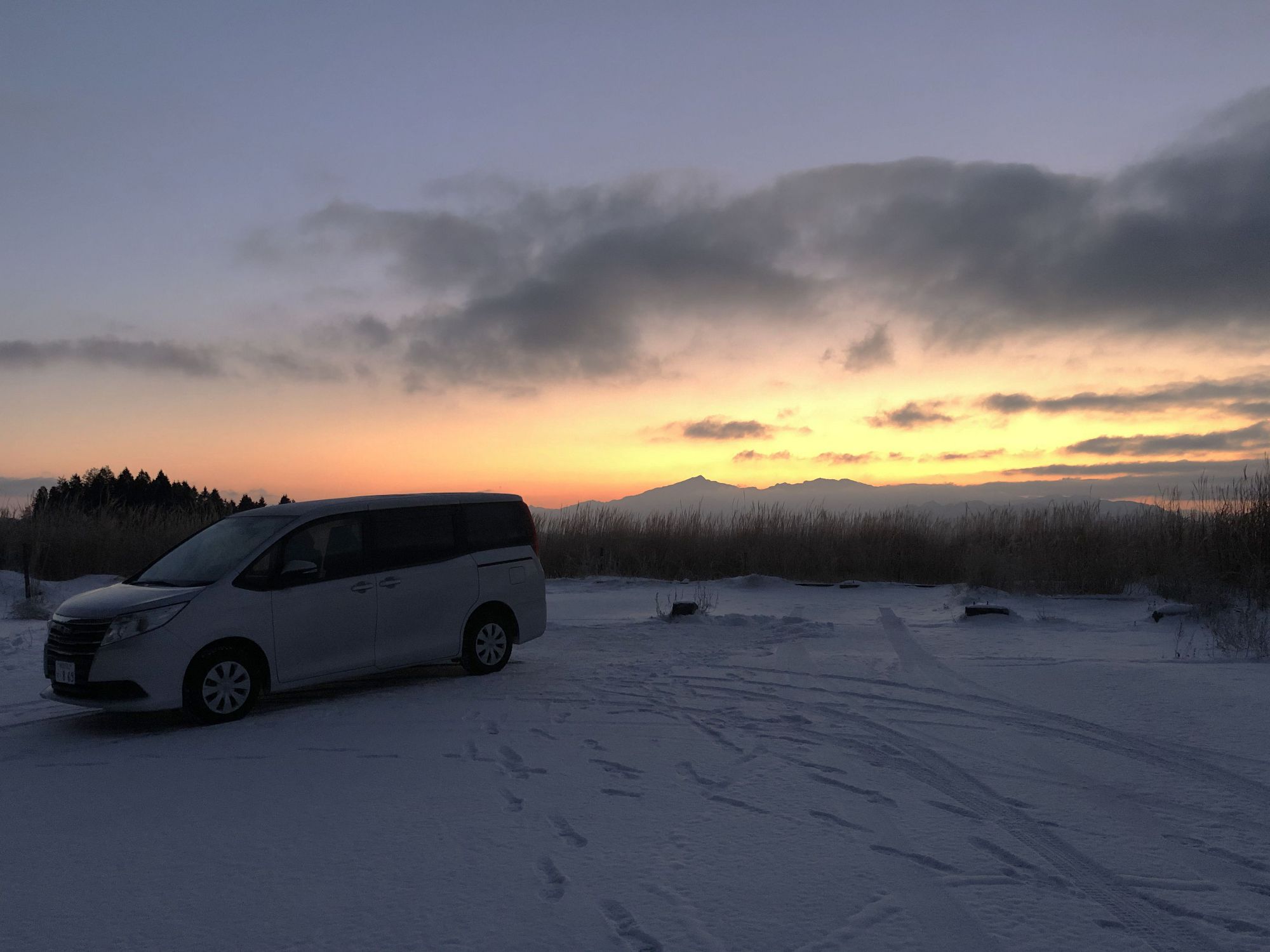
Daybreak at the site with Mt. Sobosan.
After the completion of the session there appeared clouds when I took down
my telescope. Splendid daybreak with a great view of Mt. Sobosan.
Friday, January 15
It has been nasty weather due to strong cold wave since the end of last
month, but finally, I could conduct the first comet hunting session today.
Thanks to excellent transparency and seeing I did not get tired of
watching the sky with the naked eye. Air temperature was rather high, +2°C
today, though it dropped as low as -6°C last month. What a wonderful
condition!
I began the session with M83, a galaxy in Hydra, at 4:25am using Ethos 21
mm, 97x. I noticed the spiral structure of the galaxy with direct vision,
in spite of being low altitude of the object, i.e. 22°, because of superb
sky condition. Soon after that, PGC45877, a galaxy in Virgo, came into the
FOV. It was bright as a PGC object with the magnitude of 12.1. There are a
lot of galaxies in the vicinity of M83. Galaxies I identified were NGC5086
with 5048 in the same FOV, NGC5253, PGC46511 (magnitude 15.1, at an
altitude of 35°), IC4280 and IC4310. They appeared in the FOV one after
another. Nonetheless, no galaxy was seen for some 20 minutes after I
observed IC4310. There exist many galaxies in the western part of M83, but
the number of them is much less in the eastern. I went on the searching
and NGC5247, a face on galaxy in Virgo, was in the FOV at 4:53am. The
moment when it appeared in my eye, I saw the spiral structure.

NGC5247, a galaxy in Virgo. The image is 30' wide.
The Digitized Sky Survey copyright © 1994
Small animals close at hand disturbed my comet hunting session. They were
noisy and I had a look at what they were. They turned out to be a couple
of racoon dogs and I told them "You are noisy". They went away, but
returned in a few minutes. They were distracting and I shouted "Hey you!"
to scare away them.
Zuben Elgenubi, alpha Librae, glared beautifully at just 6am in the FOV. I
identified two globular clusters in the constellation of Lupus, NGC5824
and 5986 before finishing the session at 6:13am.
Though the sky was splendid, we did not see any major objects in the solar
system like moon, planets and comets with 11th magnitude or brighter at
predawn. I will expect an appearance of a great comet.
Top of this page















